You name it, we’ve designed it.” This may seem a rather bold statement from Paul Neal about Product Partners but it is true.
From designing and developing mass produced toothbrushes and bespoke stair lifts to down lighters and inkjet print machines the size of a truck, such is the life of an industrial design consultancy.
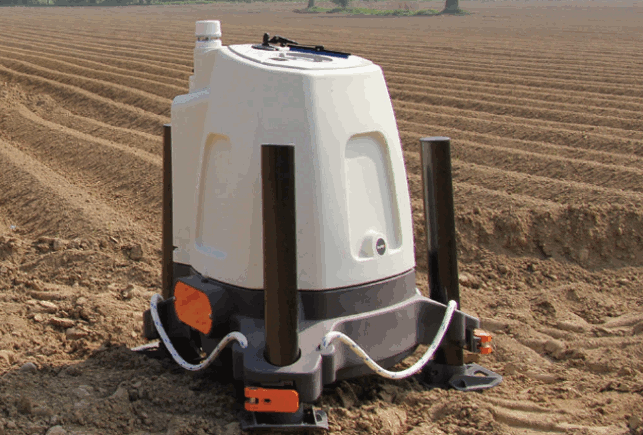
The ZephIR 300
Neal set up Product Partners together with fellow director Stephen Gallichan in Biggleswade, Bedfordshire, in 1995. Although having stayed true to its founding principles of being completely focussed on industrial design and development, they have noticed changes to their traditional set-up and workflow.
The most notable change in recent years has been the complete outsourcing of projects. Traditionally they’d design just the ‘box’, today they get involved in developing the electronics and technology that go inside the box as well as managing the production process.
As a result, Product Partners now supplements its core team of six by partnering with external suppliers depending on the project. These may include electronics and software engineers, Finite Element Analysis (FEA) experts, rapid prototyping companies, polymer suppliers, tool makers/moulders and contract manufacturers.
Its longest standing relationship has been with Ogle Models and Prototypes, a rapid prototyping and 3D printing service bureau based in nearby Letchworth.
In fact, Neal and Gallichan, having graduated in industrial design from London’s Central School of Art and Design (now Central St Martins), worked as product designers at Ogle ten years prior to establishing Product Partners. The design arm of Ogle has since been sold and today its business is focussed wholly on model making and prototyping.
“Over the years Ogle has invested heavily in SLA and SLS machines – its rapid prototyping experience is second to none and when combined with 60 years of traditional model making skills, their prototypes are the best you will find anywhere,” says Neal.
Working relationship
Depending on the prototype, Ogle will utilise the techniques and processes best suited to the job. For instance, the ICount product for Parker Hannifin, a specialist in motion and control technologies, epitomises a typical Product Partners/Ogle development relationship.
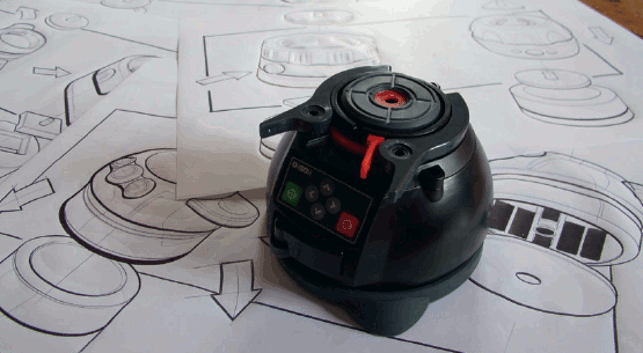
A prototype of the Ohsoh Eli
Many test rigs were made using SLS Alumide (a mix of layer sintered nylon and aluminium) to evaluate various pressure chamber designs. An aesthetic and ergonomic model for market approval was generated using a mixture of SLA and standard SLS techniques.
Let’s talk
It goes without saying that communication tools are paramount to Product Partners’ business, not just in terms of communicating successfully with all these different partners, but also maintaining a close working relationship with clients. With the latter, Neal admits that face-to-face communication is certainly preferable as it allows for instant decisions to be made.
“Without doubt, face-to-face is best and with one particular client we’ve met every two weeks for the last two years to review progress and agree the next tranche of work,” he comments.
Obviously face-to-face is not always possible and this is where video and file sharing tools, like Skype and WebEx web conferencing, come into their own.
Actually, Product Partners was an early adopter of video conferencing using it for the first time during a development project with Parker Hannifi n’s Digiplan Division, based in Dorset, in 1999.
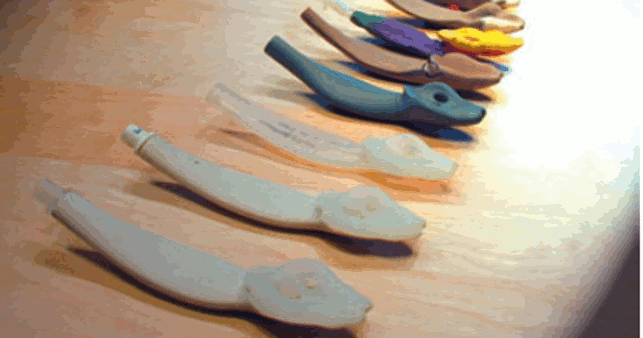
The various prototypes of the Supraglottic Airway Management System (SAMS
“As a development team we experimented with an early desktop video conferencing/application sharing software to develop a range of motor speed controllers.
“It was pretty awful stuff and the sound quality was terrible, but we entered the experience in the Manufacturing Industry Achievement Awards (MIAA) 2000 in the category ‘Most Effective Partnerships’ and surprisingly we won, beating off competition such as Johnson Controls, Jaguar Cars and Schneider Electric.
We also had the privilege of meeting Bob Monkhouse at the prize giving! However, we pretty much dumped the software after this development exercise,” says Neal.
Managing expectations
Over the years Product Partners has worked with many clients all of whom have had their own unique requirements, different types of product, timescales and experience (or inexperience) of developing new products.
The challenge has been to manage expectations. As Neal says, it’s often clients who haven’t worked with designers before who have unrealistic expectations. For instance, they may assume that a prototype can simply be manufactured from a written description or a ‘back of an envelope’ sketch. Or having seen a realistic rendering, they presume the product is done. They don’t understand that product development is a step-by-step process with various stages from ideation through to production.

Foam model of the ICount…Ogle created an ergonomic model using a mixture of SLA and SLS
“The skill when it comes to managing expectations is to build a client working relationship that includes all the major decision makers from the outset ensuring their ‘buy-in’ to the evolving product development and guaranteeing no surprises when the product is eventually manufactured,” explains Neal.
Over the years, Product Partners has also worked with a number of lone inventors and entrepreneurs. For instance, it worked with an anaesthesiologist for an intense period developing, testing and licensing his novel and now very successful medical device – the Supraglottic Airway Management System (SAMS).
More recently, it was approached by Graham Manson, an amateur photographer from New Zealand, who’d come up with an idea for a camera levelling device. Manson felt that, although tripods are crucial to achieving sharp photographs, they are cumbersome to lug around and his solution was a device that could set the camera level quickly on most surfaces and could easily fit into his camera bag.
Having proved the basic concept himself through some simple motorised experiments, Manson turned to Product Partners, which he found through a web search, to refine his idea for the Ohsoh Eli (Electronic Levelling Intelligence) device and help him bring it to market.
A gimble drive mechanism, which is a pivoted support that allows movement in all directions from a single point – rotation and infinite angle adjustment, was key to providing the levelling and panning requirements needed. However, designing such a mechanism from scratch would have doubled or even trebled the development cost.
Luckily Product Partners had previous experience of a simple off -the-shelf mechanism used to power adjustable car wing mirrors manufactured by Eaton Automotive. This proven product is not only low cost but production is guaranteed for 20 years.
Local electronics development and PCB manufacturing company BELA Electronics came on board to design the electronics and software to drive the gimble, create prototypes and production ready PCB’s. Interestingly, it was Manson who introduced Product Partners to BELA, who the consultancy has since partnered with on a number of other projects.
Manson was also keen to reap the benefits of plastic injection moulding instead of using metal clips, hinges and screw fixings to solve mechanical issues. As a result, the product includes snap-fits to secure the assemblies, integral hinges and over-centre clamps to retain the camera pinion mounting, soft over-moulded elastomers to prevent camera slip/rotation as well as a soft elastomer tri-boot to stabilise the camera on uneven surfaces.
Ogle produced various SLS and SLA prototypes making iterative modifications as the design was developed. A final set of SLA’s were created enabling silicone tooling and a small batch production run of polyurethane castings.
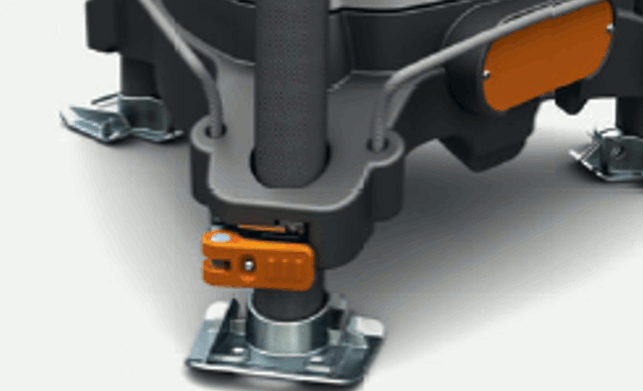
The ZephIR 300’s bespoke over centre’s clamping, carbon fibre legs and aluminium feet to prevent slip and sink
But, in the final stage, with OHSOH Eli ready for manufacture, Manson admitted to having run out of money. So, at the end of last year he decided to launch a Kickstarter crowdfunding campaign to raise the funds, which unfortunately didn’t meet the funding target.
“It’s arguable that he should have taken the Kickstarter route at an earlier stage in the development, but you do need to give him credit for trying,” says Neal. “But this knockback hasn’t stopped him making plans for another Kickstarter attempt …watch this space!”
All about the money
Ensuring a product is price competitive is a focus of all client briefs, whether it be cheaper to make, easier to assemble, lighter to transport and at the end of its life; simple to dispose/recycle.
“I haven’t met a client yet who hasn’t included ‘cost reduction’ in the development brief,” admits Neal. “It’s always at the forefront of our minds, whether it be our latest electronics product for Deep Sea Electronics where plastic cases utilise snap fits to not only reduce the part count (no screws) but also increase the speed of assembly.
Or toothbrushes for Wisdom where a gram of plastic material in a single toothbrush can result in tonnes of additional material (and cost) when manufacturing many millions of brushes per year.”
Foot in the door
Product Partners not only gets repeat business from clients but also new business via word of mouth and contacts the team have made.
For instance, the development of Natural Power’s ZephIR 300, a lidar wind speed detection, measurement and recording system for long term analysis of potential sites for wind farms, came about as the senior designer at Product Partners is friends with the engineering manager at Natural Power, a renewable energy consultancy.
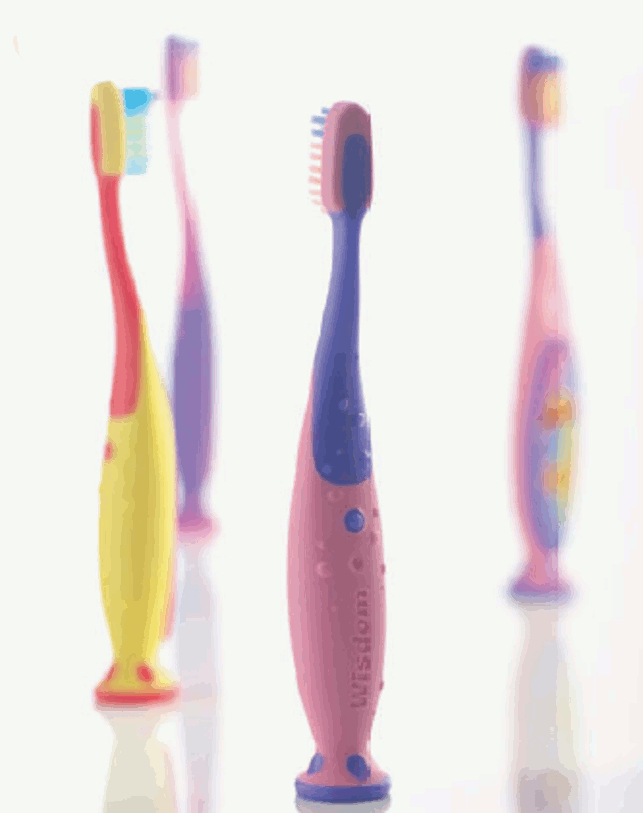
For Wisdom, Product Partners created a collection of four toothbrushes for the whole family
“Yes, this certainly gave us ‘a foot in the door’, but we still needed to compete for the work against a number of other UK consultancies and we understand we were chosen not just for our creativity but also for our renowned engineering skills and competence to take products to market,” comments Neal.
The brief from Natural Power was to review its alpha prototype and to design, develop, prototype and manufacture a user friendly, distinctive and durable product to meet pre-determined budget requirements.
The 55kg ZephIR 300 with its three carbon-fibre legs and purpose designed cast aluminium feet, is now in volume production and commercially deployed worldwide. “The resulting product is a typical Product Partner development; rugged, high value and successfully deployed on and off – shore worldwide.”
As soon as briefs land at Product Partners, so projects are delivered. Currently it has projects for new and long term clients who manufacture black-out blinds, electric motors, LED lighting controls, internet shopping devices, sewer/drainage camera apparatus, fishing equipment and casino gaming machines. “We are always pleasantly surprised to see who will next make contact for their new product development,” smiles Neal.
Close collaboration reaps rewards for industrial design consultancy Product Partners
Default






